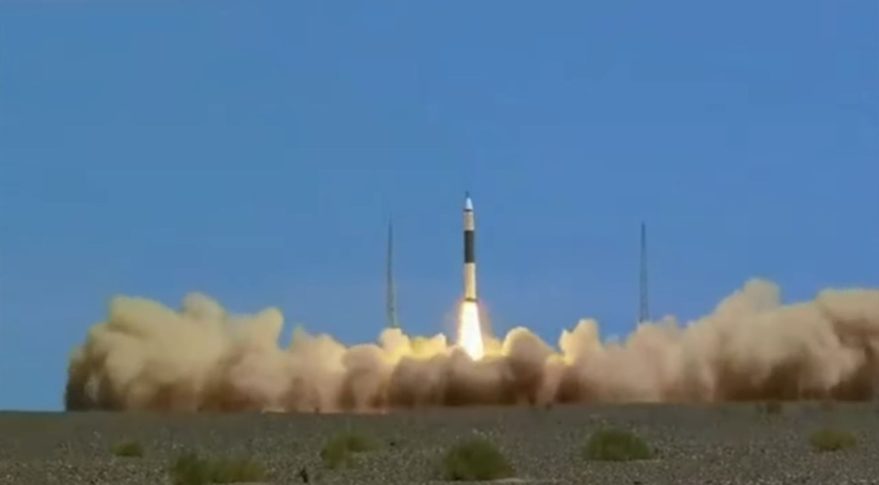China's Kuaizhou-11 rocket fails hours after Long March booster soars to space
China confirmed its Kuaizhou-11 rocket failed after launching today (July 10) from the Jiuquan Satellite Launch Center in northwest China. The cause for failure is currently being evaluated.
This failure comes just one day after the country launched another rocket type successfully from the Xichang Satellite Launch Center in southwest Sichuan China.
A press release from state media source Xinhua stated that a "malfunction" happened after the liftoff at 12:17 p.m. Beijing time (12:17 a.m. EDT or 0417 GMT). "The specific cause of the failure is under further analysis and investigation," Xinhua added.
Video footage of the launch, which is available via a delayed stream, shows that the rocket worked well in the first minute of the launch and the first and second stage separations appeared to be successful, according to SpaceNews.com.
Kuaizhou-11 (also known as KZ-11) was attempting to launch on its first mission after several delays in development and was carrying two satellites into space. The rocket was first developed in 2015 and its first launch was initially scheduled for 2018, according to NASASpaceflight.com.
There were two satellites on board the failed rocket. CentiSpace-1 S2 (also referred to as Xiangrikui 2 or Weili-1-02 in media reports) was part of a satellite series for low-Earth orbit navigation. Jilin-1 Gaofen-02E (also called BilibiliSat) is a remote sensing satellite intended for commercial applications, specifically for managing geological disasters and natural resources.
KZ-11 was developed by the China Aerospace Science and Technology Corp. and commercialized by the China Space Sanjiang Group Corporation (Expace), according to NASASpaceflight.com. The rocket can send up a payload with a mass of up to to 220 pounds (100 kilograms) to sun-synchronous orbit in a medium-altitude Earth orbit that allows for consistent lighting conditions below. Alternatively, it can send a payload of up to 3,300 pounds (1500 kg) to low-Earth orbit. A KZ-11 represents one of several commercial efforts in China to supplement the country's traditional reliance on government-funded launches, an analyst told SpaceNews.com.
Breaking space news, the latest updates on rocket launches, skywatching events and more!
While this launch, which was the 19th launch from China in 2020, resulted in failure, the country's 18th launch of the year which took place the day before successfully lifted the APSTAR-6D telecommunications satellite into space aboard the veteran Long March 3D rocket type. This launch was captured in footage by state media source China Central Television (CCTV). It blasted off at 8:11 p.m. Beijing time (8:11 a.m. EDT or 1211 GMT) on Thursday (July 9).
APSTAR-6D is expected to last about 15 years in space in geostationary orbit, as part of a broadband satellite communications system serving the Asia-Pacific region, CCTV added in a news report. The satellite is designed to provide high-speed communications with a capacity of about 50 gigabytes per second.
The APSTAR-6D satellite was developed by the China Academy of Space Technology, a subsidiary of China Aerospace Science and Technology Corp. The satellite was purchased by APT Mobile SatCom Limited in 2016.
Should APSTAR-6D work, it will be the first time China's Dongfanghong-4 satellite platform (DFH-4E) will be used in space. DFH-4E has components meant to reduce the mass of the satellite platform and to create more room for payloads on the rocket, according to SpaceNews.com.
DFH-4E's launch comes after two earlier failures of the platform, SpaceNews added. A ChinaSat-18 spacecraft power failure occurred immediately after launch in August 2019 and a second attempt in April this year saw the Long March 3B rocket and the Nusantara-2 Indonesian satellite destroyed.
Follow Elizabeth Howell on Twitter @howellspace. Follow us on Twitter @Spacedotcom and on Facebook.

Elizabeth Howell (she/her), Ph.D., was a staff writer in the spaceflight channel between 2022 and 2024 specializing in Canadian space news. She was contributing writer for Space.com for 10 years from 2012 to 2024. Elizabeth's reporting includes multiple exclusives with the White House, leading world coverage about a lost-and-found space tomato on the International Space Station, witnessing five human spaceflight launches on two continents, flying parabolic, working inside a spacesuit, and participating in a simulated Mars mission. Her latest book, "Why Am I Taller?" (ECW Press, 2022) is co-written with astronaut Dave Williams.

